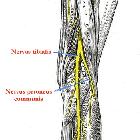Nervus tibialis



The tibial nerve is one of two terminal branches of the sciatic nerve and supplies the leg and foot with motor and sensory supply.
Summary
- origin: one of two terminal branches of the sciatic nerve in the lower third of the thigh
- course: courses through the popliteal fossa, passing deep to gastrocnemius to pass under the flexor retinaculum at the ankle
- major branches
- motor supply: posterior compartment of the thigh, posterior compartments of the leg (superficial posterior and deep posterior) and the muscles of the sole of the foot
- sensory supply: articular branches to knee, ankle and foot joints; cutaneous branches to posterior calf and sole of the foot
Gross anatomy
Origin
Fibers arise from the anterior divisions of the L4 to S3 nerve roots in the sacral plexus to form the tibial component of the sciatic nerve. It forms its own discrete nerve after the terminal division of the sciatic nerve, usually in the lower third of the thigh.
Course
Passes straight down through the popliteal fossa, posterior to the popliteal vessels, to pass inferiorly between the heads of gastrocnemius and deep to the soleus muscle. It then runs deep to soleus on tibialis posterior in the midline. The posterior tibial artery is also crossed over from medial to lateral. Emerges to pass under the flexor retinaculum in the tarsal tunnel, enclosed in a synovial sheath containing the posterior tibial vessels. At the level of the medial malleolus it divides into three terminal branches: medial and lateral plantar nerves, and the medial calcaneal nerve.
Branches and supply
- articular twigs to the knee, ankle and foot joints
- muscular branches in the posterior compartment of the thigh (as the tibial part of the sciatic nerve) and the posterior compartments of the leg (superficial posterior and deep posterior compartments)
- sural nerve
- medial sural cutaneous nerve
- terminal branches in the foot
Siehe auch:
und weiter:

 Assoziationen und Differentialdiagnosen zu Nervus tibialis:
Assoziationen und Differentialdiagnosen zu Nervus tibialis:
